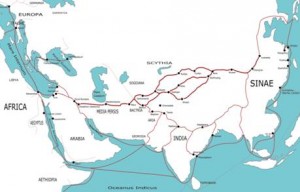Silk Route:
- The Silk Road was a network of trade routes, formally established during the Han Dynasty of China, which linked the regions of the ancient world in commerce.
- This term was coined by the German geographer and traveler, Ferdinand von Richthofen, in 1877 CE, who designated them ‘Seidenstrasse’ (silk road) or ‘Seidenstrassen’ (silk routes).
- The network was used regularly from 130 BCE, when the Han officially opened trade with the west, to 1453 CE, when the Ottoman Empire boycotted trade with the west and closed the routes.

Trade routes:
- While many different kinds of merchandise travelled along the Silk Road, the name comes from the popularity of Chinese silk with the west, especially with Rome.
- The Silk Road routes stretched from China through India, Asia Minor, up throughout Mesopotamia, to Egypt, the African continent, Greece, Rome, and Britain.
- The northern Mesopotamian region (present day Iran) became China’s closest partner in trade, as part of the Parthian Empire, initiating important cultural exchanges.
- Paper, which had been invented by the Chinese during the Han Dynasty, and gunpowder, also a Chinese invention, had a much greater impact on culture than did silk.
- The rich spices of the east, also, contributed more than the fashion which grew up from the silk industry.
- Even so, by the time of the Roman Emperor Augustus (27 BCE – 14 CE) trade between China and the west was firmly established and silk was the most sought after commodity in Egypt, Greece, and, especially, in Rome.